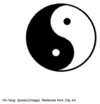week 1, concept 1 : Yin Yang theory Flashcards
(63 cards)
Learning Outcomes:
- State the fundamental theories of Yin & Yang theory
- Identify the application of Yin & Yang in CM
- State the fundamentals of the 5 element theory.
- Examine the basic qualities of 5 elements
- Identify the cycles of the Elements.
concept of yin & yang
(2)
- Yin & Yang are complementary opposites.
- All things can be classified according to Yin & Yang.
yin yang symbol
(visual)

Meaning of Yin & Yang
Yin & Yang relate to the dark & sunny side of a hill.

BASIC PRINCIPLES OF YIN & YANG
(4)
- The Fundamental opposition of Yin & Yang.
- The Interdependence of Yin & Yang
- Mutual consumption of Yin & Yang
- The Inter-transformation of Yin & Yang
- THE FUNDAMENTAL OPPOSITION OF YIN & YANG.
(3)
- The opposite is relative and by no means is absolute.
- Nothing is totally Yin or totally Yang.
- Everything contains the seed of its opposite .
PRIMARY OPPOSITES - BASIC PROPERTIES
(7 each)
YIN - YANG
(yin - dcissdi)
- dark - light
- cooling - warming
- inaction - action
- substance - function
- soft - hard
- descending V - acending ^
- Inward - outward
- THE INTERDEPENDENCE OF
YIN & YANG
(2)
- Yin & Yang cannot be separated and cannot exist without the other.
- Day cannot exist without night.
- MUTUAL CONSUMPTION OF YIN & YANG
(2)
- Yin & Yang are in a constant stage of change.
- There are 4 possible states of imbalance: excess Yang, excess Yin, deficient Yin, deficient Yang.
YIN & YANG COUNTERBALANCE EACH OTHER
Yin Yang

equilibrium relative balance
PREPONDERANCE OF YANG CONSUMES YIN
Yin - Yang

PREPONDERANCE OF YIN CONSUMES YANG
yin - yang

- THE INTER-TRANSFORMATION OF
YIN & YANG
(2)
- Yin changes into Yang & vice versa.
- This change does not happen randomly but when internal conditions are ripe & when time is right i.e. day into night.
- THE INTER-TRANSFORMATION OF
YIN & YANG
(visual)

APPLICATION OF YIN & YANG IN CM
- regional
- anatomy
- internal anatomy
Regional Anatomy
YIN YANG LOWER UPPER
INTERIOR EXTERIOR
ABDOMINAL SURFACE DORSAL(BACK)
Internal Anatomy
VISCERA (ZANG-YIN ORGANS) BOWELS (FU-YANG ORGANS)
HEART GALL BLADDER
LIVER STOMACH
SPLEEN INTESTINES
LUNG BLADDER
KIDNEY SAN JIAO (triple burner)
APPLICATION OF YIN & YANG IN CM
(visual)

APPLICATION OF YIN & YANG IN CM
- Individuals can be characterised as being more Yang or Yin based on body structure & character. But people can manifest qualities of both.
Yang body:
Yin Body:
WHICH ONE ARE YOU???
YIN ORGANS
The YIN organs (Zang) include:
(5)
and main functions of YIN organs?
YIN organs (Zang)
- Heart
- Lung
- Spleen
- Liver
- Kidneys
HLSLK
The main functions of the Yin organs are to manufacture & store essential substances.
YIN = Solid organs
YANG ORGANS
The YANG organs (Fu) include:
(6)
and main functions of YANG (Fu) organs?
YANG organs (fu)
- Gall bladder
- Stomach
- Small Intestines
- Large Intestines
- Bladder
- San Jiao (triple burner)
GSIBS
The main functions of the Yang organs are to receive,
digest food, transmit & excrete wastes.
YANG = hollow organs (fu)
Blood is _?
Qi is _?
The function of an organ is classified as _?
and the substance is classified as _?
Blood is Yin
Qi is Yang
The function of an organ is classified as Yang
and the substance is classified as Yin
PARTNER ORGANS
Each Yin organ is related to a Yang organ:
- Lung/Large Intestine
- Spleen/Stomach
- Kidney/Bladder
- Liver/Gallbladder
- Heart/Small Intestine
- Pericardium/Triple Burner (San Jiao)
what are the 4 possible states of Yin Yang imbalance?
- excess Yang
- excess Yin
- deficient Yin
- deficient Yang.
Yin Yang symbol
represents?
“Supreme Ultimate”
( Tai Ji )
Unity and Duality
outer circle of the Yin Yang symbol represents?
The outer circle represents everything.


